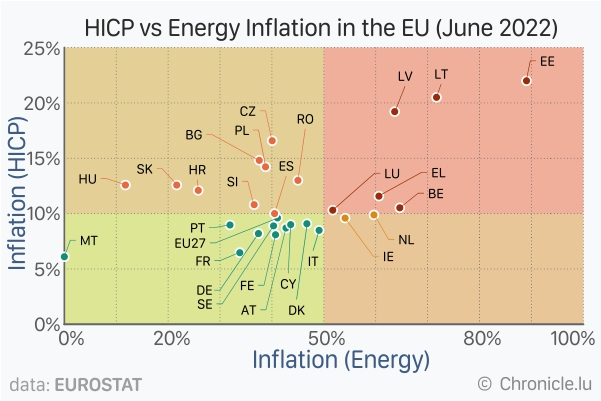
The annual inflation rate with respect to the Harmonised Index of Consumer Prices (HICP) is estimated to have reached 9.6% in June 2022 in the European Union (EU), with more than half (fifteen) of the Member States, including Luxembourg, reporting double digits, according to a flash estimate by European statistics agency Eurostat.
Estonia, Latvia and Lithuania have effectively lost a major trading partner, Russia, following the EU sanctions, and this has taken a heavy toll on their economies. According to Eurostat's flash estimate, Estonia recorded an estimated inflation rate of 22.0% in June 2022 (the highest in the EU), closely followed by Lithuania (20.5%) and Latvia (19.2%). Estonia and Latvia share borders with Russia, while Lithuania shares a border with Kaliningrad, an exclave of the Russian Federation.
Luxembourg reported an estimated annual inflation rate of 10.3% in June 2022, the highest recorded since 1997, when the earliest data are available on Eurostat.
According to national statistics agency STATEC, Luxembourg's official annual inflation, in accordance with the national consumer price index (indice des prix à la consommation national - IPCN), for June 2022 stood at 7.4%, marked particularly by an increase in the price of petroleum products by 6.1% in one month and a continued increase in prices of food products.
IPCN is the consumption in the Grand Duchy by Luxembourg households whilst HICP accounts for total consumption on the national territory, including that of non-residents.
Among the main components of HICP inflation, energy had the highest annual rate in June 2022 (41.1% across the EU, compared with 37.7% in May 2022).
Comparing the HICP inflation together with energy inflation across the EU Member States, fifteen countries reported annual inflation of 10.0% or more, while six of them, namely Belgium, Estonia, Greece, Latvia, Lithuania and Luxembourg, also reported energy inflation of 50% or more.
Excluding Estonia, Latvia and Lithuania, the high energy inflation in Belgium, Greece and Luxembourg could be partially explained by their heavy energy imports dependency, with Belgium (78.1%), Greece (81.4%) and Luxembourg (92.5%) being among the top five heavily energy imports dependent EU Member States in 2020. Malta reported the highest energy imports dependency at 97.6% in 2020, but no price movements have been registered since the decrease in energy prices that took place in July 2020 (energy prices in Malta are regulated by the government) and hence 0% energy inflation is shown, followed by Greece at 93.1%.
In terms of HICP and energy inflation combined, France has fared the best so far with HICP at 6.5% and energy inflation at 33.8% in June 2022, followed by Portugal (HICP: 9.0%, energy: 31.9%).
Note: Concerning the inflation in HICP (all items), since inflation is measured annually, which means that June 2022 is compared to June 2021, while for the previous month, May 2022 is compared to May 2021, a big part of the variation may be explained by price changes that happened between May and June 2021. Moreover, even though food, alcohol and tobacco account for 20.9% and energy accounts for 10.9% of total household consumption in the EU, together they could have a significant impact on the headline inflation if their prices fluctuate significantly more than other components like services or non-energy industrial goods.
Regarding inflation rates in energy products across the EU, Eurostat noted that in light of the recent increases in energy prices, a lot of countries have introduced different compensation measures and these vary widely between the different countries. These measures may impact the prices differently and consequently, their measurements at national level as well, which might partly explain the wide variations in energy inflation rates noted between Member States.








